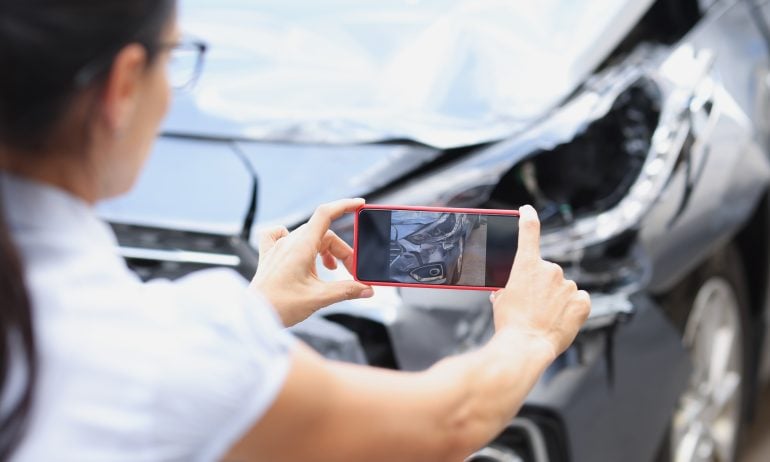Texas Liability Insurance: What It Covers and How Much You Need
Liability car insurance is required in Texas and pays for injuries and damage you may cause while behind the wheel.

Many, or all, of the products featured on this page are from our advertising partners who compensate us when you take certain actions on our website or click to take an action on their website. However, this does not influence our evaluations. Our opinions are our own. Here is a list of our partners and here's how we make money.
ALSO CONSIDER: Cheap car insurance in Texas || The best car insurance in Texas || The best home insurance in Texas || The best cheap renters insurance in Texas
Texas liability insurance is there to protect your finances when uncertainty strikes on the road. Say you’re driving along Interstate 30 and there’s a slowpoke in front of you. You go to switch lanes but don't see the pickup truck coming up next to you. You hit the truck and send it careening into the guardrail. Everyone is OK, but the other driver’s pickup is kaput.
Without insurance, you’d be responsible to pay the other driver for a replacement truck. But you have enough liability car insurance to foot the bill on your behalf.
Liability car insurance is required to drive legally in Texas and pays for injuries and damage you cause if you’re found at-fault after an accident. But it won’t pay for everything.
Keep reading to learn:

See what you could save on car insurance
Easily compare personalized rates to see how much switching car insurance could save you.What does Texas liability insurance cover?
When you buy liability car insurance in Texas (or anywhere else for that matter), you’ll notice it comes in two parts:
Bodily injury liability. This pays others’ costs for things like medical bills, lost wages, pain and suffering and funeral costs if they’re injured in a traffic-related accident you cause. It can also cover your own lawyers’ bills or court fees if you’re sued after an accident.
Property damage liability. This pays others’ costs to repair property you damage in a traffic-related accident you cause, such as someone else’s car or fence. It may even pay for other people’s belongings destroyed in a car accident, or a rental car for the other driver.
What does Texas liability insurance not cover?
Here are some examples of what liability car insurance in Texas won’t pay for:
Your own medical bills, pain and suffering or lost wages.
Medical costs for household members injured in an accident you cause.
Costs to repair or replace your car or truck.
Towing services for your vehicle.
A rental car while yours is in the shop.
Texas liability insurance requirements
In Texas, drivers are required to have a minimum amount of liability insurance to drive legally. These minimum requirements are expressed as “limits” and come in three parts:
Bodily injury limit per person ($30,000). This is the maximum your insurer will pay for injuries to a single person after an accident you cause. You’re required to have at least $30,000 in bodily injury liability coverage per person in Texas.
Bodily injury limit per accident ($60,000). This is the maximum your insurer will pay for injuries to everyone hurt in an accident combined (minus you and household members). In Texas, you’re required to have at least $60,000 in bodily injury liability coverage per accident.
Property damage limit per accident ($25,000). This represents the maximum your insurer will pay for total property damage you cause in an accident. You must have at least $25,000 in property damage liability coverage in Texas.
Take note: If you lease your vehicle, chances are your leasing company will require you to have higher liability limits than Texas’ minimum requirements, plus collision and comprehensive coverage.
As a general rule, you’ll want enough liability insurance to cover your net worth, which is the value of all your cash and investments and the things you own, minus your debt. While Texas’ minimum liability insurance limits are all you need to drive legally, medical and repair costs can be hundreds of thousands of dollars after a bad crash. You'll be required to pay out of pocket and be held personally responsible for any costs that exceed your policy’s limits. The people you injured can sue you for that money, and you could lose your home or have your wages withheld.
Should I get more than just liability insurance in Texas?
You may be wondering what you can do to protect yourself and your family members from having to pay for repairs or hospital visits out of pocket after an accident. While other drivers are responsible for the damage they cause you and your passengers, there are many other situations you may find yourself in. This is where optional types of car insurance coverage can come in handy.
In the below table, we've highlighted common coverage types that may help you out after an accident (regardless of fault):
Coverage type | What it pays for |
|---|---|
Medical and repair costs for you and your passengers after an accident with an uninsured or minimally-insured driver. In Texas, you must tell your insurer in writing if you decline this coverage. | |
Your own car repair expenses from traffic-related accidents, whether you’re at-fault or not. | |
Your own car repair costs from events outside of your control, such as weather events, theft or hitting an animal. | |
Medical expenses, lost wages, funeral costs and more for you and your passengers due to an accident, regardless of fault. In Texas, you must tell your insurer in writing if you decline this coverage. | |
Medical expenses for you and your passengers after an accident, regardless of fault. | |
A battery jump or towing service if your vehicle breaks down. | |
* If you lease or finance your vehicle, your lender will likely require you to have comprehensive and collision insurance | |
How much does liability car insurance cost in Texas?
Minimum liability car insurance in Texas is $774 per year on average. This is higher than the $685 national average.
But your own price may vary, sometimes by a lot. That’s because insurers in Texas and other states base their rates on a dizzying array of factors, including your age, the vehicle you drive, where you live, your credit-based insurance score and more.
If it’s cheaper rates you’re after, check out NerdWallet’s analysis of cheap car insurance in Texas to find insurers offering the most competitive rates in the state.
But there’s more to car insurance than a rock-bottom price. Other things to consider when picking an insurer are customer satisfaction, ease of use, coverage types offered and discounts available. This is where NerdWallet’s roundup of the best car insurance in Texas has your back.

See what you could save on car insurance
Easily compare personalized rates to see how much switching car insurance could save you.What happens if I drive without liability insurance in Texas?
You don’t mess with Texas — and that includes Texas law. The penalties for driving without liability car insurance in Texas depend on the number of times you’ve been caught. But generally, you can expect:
Fines as high as $1,000.
Impoundment.
Suspended driver's license and car registration.
Higher car insurance premiums.
NerdWallet averaged rates based on public filings obtained by pricing analytics company Quadrant Information Services. We examined rates for 35-year-old men and women for all ZIP codes in all 50 states and Washington, D.C. Although it’s one of the largest insurers in the country, Liberty Mutual is not included in our rates analysis due to a lack of publicly available information. Poor credit rates from The Hanover were removed in both Connecticut and New York.
In our analysis, “good drivers” had no moving violations on record; a “good driving” discount was included for this profile. Our “good” and “poor” credit rates are based on credit score approximations and do not account for proprietary scoring criteria used by insurance providers. These are average rates, and your rate will vary based on your personal details, state and insurance provider.
Sample drivers had the minimum required coverage by law in each state. Some policies include additional coverage at the insurer’s discretion.
We used a 2020 Toyota Camry L for all drivers and assumed 12,000 annual miles driven.

